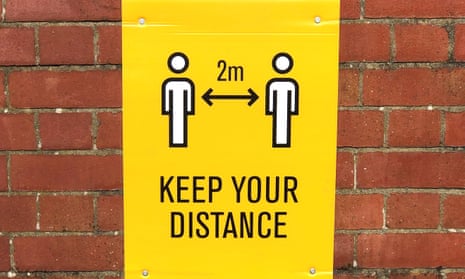The business secretary, Alok Sharma, has said the 2 metre distancing rule remains under review in England, despite the prime minister’s hope that his scientific advisers would give the green light to relax it imminently.
Boris Johnson has made clear that he is keen to ease the rule, as the government battles to prevent thousands of hospitality businesses collapsing in the coming months.
No 10 is understood to have told senior figures in the sector that the idea of reducing physical distancing to 1 metre would be discussed at Tuesday’s cabinet meeting.
Cabinet also received an update on the virus from chief medical officer Chris Whitty and the chief scientific adviser, Sir Patrick Vallance.
It came as Sharma confirmed that non-essential shops could open from Monday, saying the move would “allow high streets up and down the country to spring back to life”.
Last week, Johnson was alarmed by warnings that more than 3 million jobs could be lost if the guidelines remained unchanged, making it impossible for many pubs and restaurants to reopen.
Ministers including Sharma and the chancellor, Rishi Sunak, point to the 1 metre limit recommended by the World Health Organization and followed by France, while the rule is 1.5 metres in countries including Germany and Australia.
But the government’s scientific advisers have repeatedly expressed caution about changing the simple, across-the-board guidance, which has been a key part of the approach to limiting the spread of the virus.
Whitehall sources suggested one proposal under discussion was a compromise, in which the strict 2 metre minimum would be relaxed where other precautions, such as face coverings, seating people back to back and limiting face-to-face interactions, could be put in place.
Dr Shaun Fitzgerald, of Girton College, Cambridge, who sits on Sage’s environmental working group, said: “As a scientist, it would absolutely make sense to me that if you can’t maintain 2 metre distancing at all times, then consider other factors which influence risk and introduce some other measures.”
But he added: “The 2 metre guidance rule in the way it has been set out has been really helpful, because there is elegance in the simplicity of a message. Just saying 2 metres is something we can all relate to, we can all understand.”
The prime minister told MPs at the liaison committee last month: “My own hope is that as we make progress in getting the virus down, in reducing the incidence, we will be able to reduce that distance, which I think will be particularly valuable in transport and clearly the hospitality sector.”
But Whitty struck a more cautious tone on Wednesday, saying measures including handwashing, “good cough etiquette”, the use of face coverings and the 2 metre rule were “going to carry on really for as long as this epidemic continues”.
Whitty’s appearance was the last time scientists accompanied ministers at the daily press conference. Johnson will present Wednesday’s briefing, and one Whitehall source suggested he had been expected to make an announcement on the distancing rule.
Trade bodies such as UK Hospitality and the British Beer & Pubs Association (BBPA) have submitted estimates showing escalating numbers of closures and job losses based on social distancing, at 1m, 1.5m and 2m.
If the required distance is not reduced, so-called “wet-led” pubs, which rely more on the sale of alcohol than food are likely to be particularly hard hit, because they need to pack in drinkers in large numbers.
The BBPA has also voiced concern at the prospect that pubs could lose access to the furlough scheme and grant support if they are technically allowed to open, even if the reality of physical distancing rules means that many cannot.
The trade body wants the government to provide financial backing to any pubs that are rendered unviable as businesses as a result.
Sharma was asked about the issue at Tuesday’s Downing Street press conference. “The 2 metre rule is currently in place. We of course take advice from our scientists, from Sage. And of course, when it is safe to do so, we will see whether we can move to a shorter distance. Ultimately we keep all of these things under review,” he said.
Asked about other countries with smaller distances in place, Sharma said: “Of course, they are further along in terms of their roadmap, but we keep these things under review.”
He added: “I completely understand why, for economic reasons, businesses will want to take a look at this 2 metre rule.”
Car showrooms and outdoor markets were allowed to reopen earlier this month. Sharma said other retailers would now be able to follow suit, provided they complied with government safety guidelines, and carried out a risk assessment.
“This is the latest step in the careful restarting of our economy, and will allow high streets up and down the country to spring back to life,” he said.
Sharma said his department would shortly publish safety guidelines for other businesses, including pubs, restaurants, hairdressers and nail bars. “These documents will provide practical steps which will allow these businesses to reopen safely,” he said.
However, he rejected the idea, floated in multiple reports in recent days, that pubs could be allowed to open earlier than previously planned. “We continue to follow our roadmap, which sets out our ambition to reopen these businesses on 4 July at the earliest,” he said.
